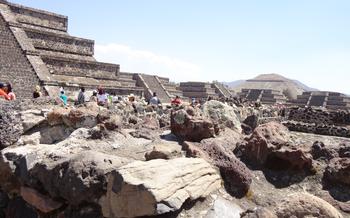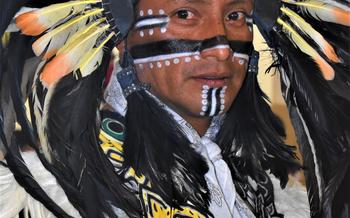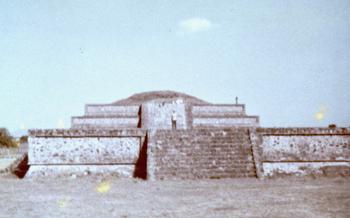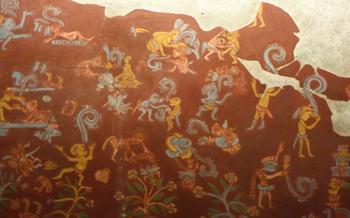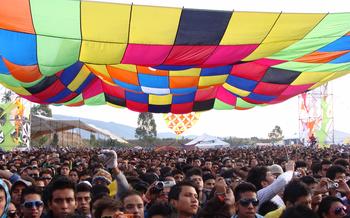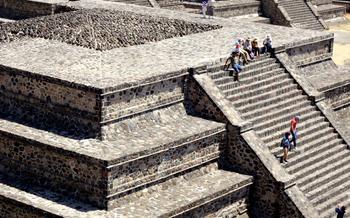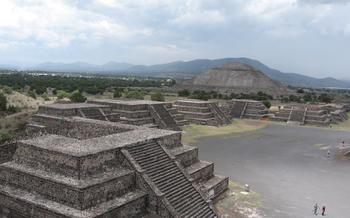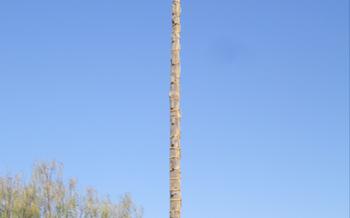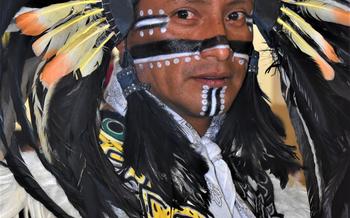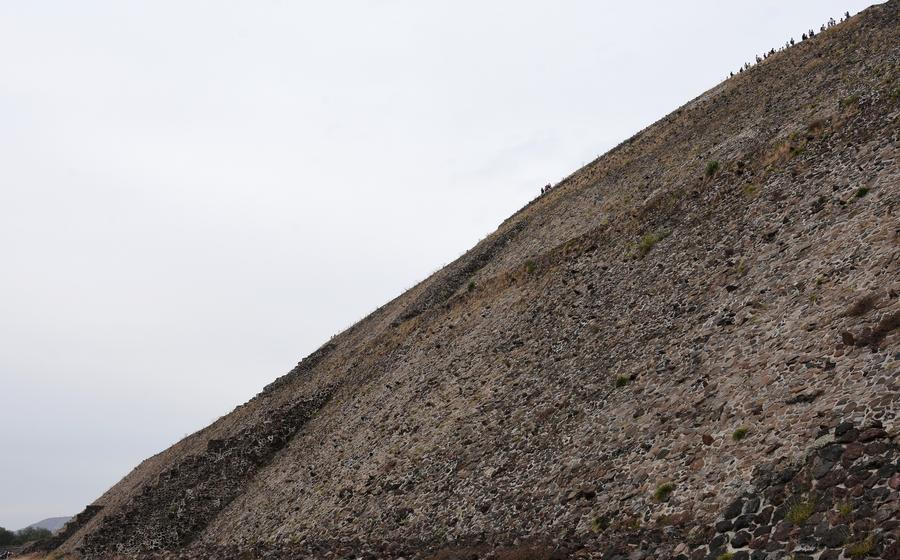
San Ildefonso College
- A Monumental City in the Valley of Mexico
- Exploring San Ildefonso College
- The Anthropological Museum of San Ildefonso: A Journey into Teotihuacan's Past
- Unveiling the Murals of Teotihuacan
- Exploring the Temples and Pyramids
- Walking the Avenue of the Dead
- Discovering the Teotihuacan Market
- Unraveling the Mysteries of Teotihuacan's Water System:
- Learning about Teotihuacan's Unique Writing System
- Experiencing the Vibrant Culture of Teotihuacan
- Visiting the Teotihuacan Museum Zone
- Capturing the Beauty of Teotihuacan
- Planning Your Visit to San Ildefonso College:
- Respecting the Heritage of Teotihuacan:
- Insider Tip: Exploring Beyond the Main Attractions
A Monumental City in the Valley of Mexico
In the heart of Mexico's Valley of Mexico, amidst a landscape dotted with cacti and ancient ruins, lies the awe-inspiring city of Teotihuacan. Once a thriving metropolis, Teotihuacan remains a testament to the ingenuity and artistry of its ancient inhabitants. Its towering pyramids, intricate murals, and sophisticated hydraulic system continue to captivate visitors from around the world, inviting them to explore the mysteries of this enigmatic civilization.
Historical Background and Significance
The origins of Teotihuacan are shrouded in mystery, but its rise to prominence occurred around the 1st century AD. Over the next several centuries, Teotihuacan grew into a major political, economic, and cultural center, influencing vast regions of Mesoamerica. Its influence extended far beyond its physical borders, as Teotihuacan's culture and trade networks reached as far south as Guatemala and as far north as the American Southwest.
Geographical Location and Impact on Development
Teotihuacan's strategic location played a crucial role in its development. Situated on a fertile plain between two lakes, the city had access to abundant water resources and rich agricultural land. The surrounding mountains provided a natural defense, while also supplying valuable building materials, such as volcanic rock and limestone.
San Ildefonso College: Preserving the Legacy of Teotihuacan
In the 16th century, Spanish conquistadors arrived in Teotihuacan and were awestruck by the grandeur of the ruins. Recognizing the city's historical significance, they established San Ildefonso College in 1548 to study and preserve the legacy of Teotihuacan. The college has since become a center for archaeological research and cultural preservation, playing a vital role in safeguarding the treasures of this ancient civilization.
A Personal Encounter with Teotihuacan's Awe-Inspiring Presence
As I stood before the towering Pyramid of the Sun, I couldn't help but feel a sense of awe and wonder. The sheer scale and majesty of the structure were overwhelming, reminding me of the incredible achievements of the Teotihuacan people. The intricate carvings and vibrant murals that adorned the pyramid transported me back in time, allowing me to glimpse into the lives and beliefs of this ancient civilization.
Exploring San Ildefonso College
San Ildefonso College, a historical gem nestled in the heart of Teotihuacan, holds a significant place in preserving and showcasing the legacy of this ancient city. Founded in 1548 by Franciscan friars, the college's mission was to evangelize the indigenous population while also preserving their rich cultural heritage.
The architecture of San Ildefonso College is a testament to its unique blend of indigenous and European influences. The main building, constructed in the 16th century, features a striking facade adorned with intricate carvings and colorful murals depicting scenes from the Bible and Mexican history. The spacious courtyard, surrounded by arched walkways and lush gardens, creates a serene and contemplative atmosphere.
Beyond its architectural splendor, San Ildefonso College serves as a vital cultural and educational center. The college houses the renowned Anthropological Museum of San Ildefonso, which boasts an extensive collection of artifacts and exhibits showcasing Teotihuacan's history, culture, and daily life. Visitors can delve into the mysteries of this ancient civilization through interactive displays, educational programs, and guided tours led by knowledgeable experts.
One unforgettable experience at San Ildefonso College was attending a traditional Mexican dance performance in the college's courtyard. The vibrant colors, rhythmic music, and graceful movements of the dancers transported me back in time, allowing me to glimpse into the rich cultural traditions of Teotihuacan. The performance was a captivating display of cultural preservation and a testament to the college's commitment to showcasing Mexico's rich heritage.
The Anthropological Museum of San Ildefonso: A Journey into Teotihuacan's Past
Within the hallowed halls of San Ildefonso College, a treasure trove of knowledge awaits those seeking to delve deeper into the captivating history of Teotihuacan. The Anthropological Museum of San Ildefonso stands as a testament to the enduring legacy of this ancient city, housing an extensive collection of artifacts and exhibits that illuminate the lives, beliefs, and artistic achievements of its inhabitants.
Established in 1978, the museum has become a cornerstone of Mexican cultural heritage, attracting visitors from around the world who seek to unravel the mysteries of Teotihuacan's past. Its vast collection encompasses stone sculptures, ceramic vessels, intricately carved bone objects, and obsidian tools, each artifact whispering tales of the city's vibrant civilization.
Interactive displays and educational programs bring Teotihuacan's history to life, engaging visitors of all ages in a multisensory exploration of the ancient metropolis. Through hands-on activities and multimedia presentations, the museum invites visitors to step back in time and experience the grandeur of Teotihuacan's rituals, trade networks, and artistic traditions.
One of the museum's highlights is the Hall of Murals, where visitors can marvel at stunning replicas of Teotihuacan's iconic murals. These vibrant and detailed artworks depict mythological scenes, deities, and everyday life, offering a glimpse into the minds and imaginations of the city's ancient inhabitants. The museum's collection also includes a replica of the famous Teotihuacan Calendar Stone, a monumental sculpture that symbolizes the city's sophisticated astronomical knowledge.
Guided tours led by knowledgeable experts provide visitors with an immersive and in-depth exploration of the museum's treasures. These tours unravel the symbolism behind the artifacts, shedding light on Teotihuacan's religious beliefs, social structure, and economic system. Visitors can also participate in workshops and lectures, where they can learn about the latest archaeological discoveries and engage in discussions with experts in the field.
A visit to the Anthropological Museum of San Ildefonso is an essential experience for anyone seeking to understand the grandeur and complexity of Teotihuacan. This remarkable institution serves as a guardian of the city's legacy, preserving its cultural heritage for generations to come.
Unveiling the Murals of Teotihuacan
The murals of Teotihuacan are a testament to the city's vibrant artistic expression and cultural significance. These awe-inspiring artworks adorned the walls of temples, palaces, and other structures, narrating mythological tales, depicting deities, and showcasing scenes from daily life.
The Teotihuacans possessed a remarkable mastery of mural painting techniques, using a range of natural pigments to create vivid and long-lasting colors. Their murals often depicted intricate scenes, with multiple figures and objects arranged in a harmonious composition.
One of the most famous murals is the "Procession of the Gods," found in the Temple of Quetzalcoatl. This masterpiece portrays a procession of deities, each adorned with elaborate headdresses and ceremonial attire, marching in a solemn and majestic procession.
Another notable mural is the "Paradise of Tlaloc," located in the Temple of Tlaloc, the god of rain. This mural depicts a lush and verdant paradise, filled with flowing water, exotic birds, and blooming flowers, symbolizing the Teotihuacans' reverence for nature and their belief in an afterlife.
The techniques used by Teotihuacan artists were remarkably sophisticated, demonstrating their knowledge of perspective, proportion, and color theory. They often employed a technique called "buon fresco," where pigments were applied to wet plaster, resulting in vibrant and durable murals that have withstood the test of time.
Anecdote:
During my exploration of Teotihuacan, I stumbled upon a hidden mural tucked away in a secluded corner of the city. As I carefully brushed away the dirt and debris that had accumulated over time, a breathtaking scene emerged before my eyes.
The mural depicted a group of musicians playing traditional instruments, their fingers dancing across flutes, drums, and rattles. The vibrant colors and intricate details transported me back in time, allowing me to glimpse the vibrant cultural traditions of the Teotihuacan people.
This hidden gem served as a reminder of the countless treasures that still lie undiscovered within the ruins of Teotihuacan, waiting to be revealed to those who dare to explore beyond the beaten path.
Exploring the Temples and Pyramids
Amidst the sprawling expanse of Teotihuacan, the majestic temples and pyramids stand as testaments to the city's architectural prowess and religious devotion. The Pyramid of the Sun, the largest structure in the city, dominates the skyline with its imposing presence. Visitors can ascend its steep steps to reach the summit, where they are rewarded with breathtaking panoramic views of the entire archaeological site and the surrounding valley.
The nearby Pyramid of the Moon, though smaller in size, is equally impressive in its grandeur. Its meticulously aligned terraces and intricate carvings hint at the astronomical knowledge and religious significance held by the Teotihuacan people. Other notable structures within the site include the Temple of Quetzalcoatl, adorned with vibrant murals depicting the feathered serpent deity, and the Ciudadela, a vast complex that once served as a ceremonial and administrative center.
These temples and pyramids were not merely architectural marvels but also held profound religious and ceremonial significance. They served as venues for rituals, offerings to the gods, and the enactment of sacred dramas that connected the earthly realm with the divine. Exploring these structures allows visitors to delve into the spiritual beliefs and practices that shaped the heart of Teotihuacan's ancient civilization.
Anecdote:
As the sun began its descent, casting a golden glow across the ancient city, I climbed the steep steps of the Pyramid of the Sun. With each step, the panorama unfolded before me, revealing a breathtaking vista that seemed to stretch beyond time itself. The vast expanse of the archaeological site, dotted with temples, pyramids, and the Avenue of the Dead, was a sight to behold.
As I reached the summit, the cool evening breeze enveloped me, carrying with it a sense of awe and wonder. Standing atop this monumental structure, I couldn't help but marvel at the architectural ingenuity and the sheer scale of the city that once thrived here. The moment was deeply moving, as if I had been transported back in time to witness the grandeur of Teotihuacan in its prime.
Walking the Avenue of the Dead
Stretching from the Pyramid of the Moon to the Ciudadela, the Avenue of the Dead served as the central artery of Teotihuacan, connecting the city's major structures and neighborhoods. Its symbolic importance is reflected in its alignment with the setting sun during the summer solstice, creating a mesmerizing celestial spectacle.
Flanked by impressive platforms, temples, and residential compounds, the Avenue of the Dead was a bustling hub of activity, where merchants traded goods, pilgrims made their way to sacred sites, and processions honored the city's deities. The sheer scale and grandeur of the avenue are a testament to the advanced urban planning and engineering prowess of the Teotihuacans.
As you stroll along the Avenue of the Dead, let your imagination transport you back in time to the vibrant world of Teotihuacan. Picture the avenue teeming with life, the sound of footsteps and voices echoing through the air, and the vibrant colors of the city's murals illuminating the path.
Anecdote:
During my visit to Teotihuacan, I decided to take a leisurely stroll along the Avenue of the Dead early in the morning, before the crowds arrived. As the sun cast a warm glow over the ancient ruins, I couldn't help but feel a profound sense of awe and wonder. The silence was broken only by the gentle chirping of birds and the rustling of the wind through the trees, creating an atmosphere of tranquility that allowed me to connect with the spirit of this ancient city.
Discovering the Teotihuacan Market
In the heart of Teotihuacan lies a vibrant marketplace that buzzes with activity, where locals and visitors mingle to trade goods, socialize, and immerse themselves in the authentic Mexican culture. This bustling hub, known as the Teotihuacan Market, invites you to explore an array of traditional handicrafts, souvenirs, and local delicacies that reflect the city's rich heritage.
As you step into the market, your senses are awakened by the vibrant colors, enticing aromas, and lively chatter that fill the air. Stalls laden with colorful textiles, intricate pottery, hand-carved wooden crafts, and sparkling jewelry beckon you to discover the artistry of local artisans. Take your time to browse through the unique creations, each telling a story of Teotihuacan's cultural heritage.
Indulge in the mouthwatering array of local delicacies that showcase the culinary delights of Mexico. From freshly prepared tacos overflowing with flavorful fillings to sweet pastries that melt in your mouth, there's something to satisfy every palate. Don't miss the chance to try the region's specialty dishes, such as barbacoa, a slow-cooked lamb dish, or pulque, a traditional fermented beverage made from the maguey plant.
Interacting with the friendly vendors is an essential part of the market experience. They are eager to share their knowledge about the products they sell, the techniques they use, and the stories behind their craft. Engage in friendly conversations and learn about the local culture, customs, and traditions. Their warmth and hospitality will make you feel welcomed and connected to the community.
As you wander through the market, you'll discover hidden gems that reflect the essence of Teotihuacan. From traditional clothing and accessories to unique souvenirs that capture the spirit of the ancient city, there's something for every traveler to cherish. Embrace the vibrant atmosphere, soak in the local customs, and let the Teotihuacan Market be your gateway to an authentic Mexican experience.
Unraveling the Mysteries of Teotihuacan's Water System:
In the heart of Teotihuacan, an intricate network of canals, reservoirs, and aqueducts once ensured a steady flow of water to its inhabitants. This sophisticated hydraulic engineering system is a testament to the ingenuity and resourcefulness of the Teotihuacan people. Aqueducts snaked through the city, transporting water from distant springs and rivers, while reservoirs stored water for times of drought. Canals crisscrossed the city, delivering water directly to homes and temples. The management of water was essential for Teotihuacan's urban planning and agricultural success, allowing this ancient metropolis to flourish in a semi-arid environment.
Anecdote:
As I strolled along the remnants of an ancient aqueduct, I couldn't help but marvel at the ingenuity of Teotihuacan's water engineers. The massive stone blocks, precisely cut and fitted together without mortar, formed a conduit that carried water over long distances, defying the laws of gravity. It was almost as if the Teotihuacans had foreseen the importance of water conservation and sustainability, principles that are more relevant today than ever before.
Learning about Teotihuacan's Unique Writing System
The ancient city of Teotihuacan developed its own unique writing system, distinct from those used by other Mesoamerican civilizations. This writing system consisted of a combination of logographic and syllabic symbols, allowing for the expression of complex ideas and concepts. However, despite its sophistication, the Teotihuacan writing system remained limited in its scope, primarily used for recording names, dates, and religious texts.
Archaeologists and linguists have dedicated considerable effort to deciphering the symbols and understanding the meaning behind them. While some progress has been made, the full extent of the Teotihuacan writing system remains a mystery, adding to the allure and intrigue of this ancient civilization.
Anecdote:
During my visit to the Anthropological Museum of San Ildefonso, I had the opportunity to examine some of the artifacts bearing Teotihuacan script. The intricate symbols and characters seemed to hold secrets that were waiting to be revealed. I couldn't help but feel a sense of awe and curiosity as I pondered the minds behind this enigmatic writing system.
The challenge of deciphering ancient scripts is a reminder of the enduring power of human ingenuity and the resilience of cultural heritage. As scholars continue to unravel the mysteries of Teotihuacan's writing system, we gain a deeper appreciation for the complexity and richness of this ancient civilization.
Experiencing the Vibrant Culture of Teotihuacan
The legacy of Teotihuacan extends far beyond its imposing structures and artifacts. The city's vibrant culture continues to thrive in modern Mexico, weaving itself into the fabric of daily life. Traditional festivals, ceremonies, and rituals honor the city's heritage, paying homage to the ancestors who built this ancient metropolis. Visitors have the opportunity to immerse themselves in this living culture, participating in workshops, learning from local artisans, and witnessing the intricate dances and music that keep Teotihuacan's spirit alive.
One such festival is the annual Fiesta de San Francisco, held in early October. The festival is a celebration of the patron saint of Teotihuacan, and it features colorful processions, traditional dances, and lively music. Visitors can join in the festivities, donning traditional costumes and participating in the vibrant dances that fill the streets.
Another highlight of Teotihuacan's cultural scene is the traditional dance known as "Danza de los Concheros." This mesmerizing dance is performed by groups of dancers adorned with elaborate headdresses and colorful costumes. The dance is a tribute to the ancient gods and is believed to bring good fortune and blessings. Visitors can witness this captivating performance at the San Ildefonso College or at local cultural events throughout the year.
By embracing the vibrant culture of Teotihuacan, visitors gain a deeper understanding of the city's enduring legacy. The living traditions and customs offer a glimpse into the soul of this ancient metropolis, allowing travelers to connect with the past in a meaningful and enriching way.
Visiting the Teotihuacan Museum Zone
The Teotihuacan Museum Zone is a treasure trove of cultural and historical institutions dedicated to preserving and showcasing the legacy of Teotihuacan. Among the notable museums in the area are the Teotihuacan Site Museum and the National Museum of Anthropology.
The Teotihuacan Site Museum, located within the archaeological park, offers a comprehensive overview of the city's history, culture, and daily life. Through interactive exhibits, artifacts, and multimedia presentations, visitors can gain insights into the urban planning, architecture, and social customs of Teotihuacan.
The National Museum of Anthropology, located in Mexico City, houses an extensive collection of artifacts from various pre-Columbian cultures, including Teotihuacan. Visitors can admire exquisite sculptures, ceramics, and murals that provide a glimpse into the artistic and religious expressions of the Teotihuacan civilization.
Guided tours are available at both museums, providing expert insights and helping visitors delve deeper into the complexities of Teotihuacan's history and culture. The museum zone offers a fantastic opportunity to complement your exploration of the archaeological site and gain a comprehensive understanding of this ancient civilization.
Anecdote:
During my visit to the Teotihuacan Site Museum, I was captivated by a remarkable exhibition showcasing the intricate details of Teotihuacan's ceramic art. The pottery vessels, adorned with vibrant colors and intricate designs, provided a glimpse into the craftsmanship and artistry of the Teotihuacan people. Through the museum's interactive displays, I learned about the techniques and symbolism associated with these ceramic creations, gaining a deeper appreciation for the cultural significance of this ancient art form.
Capturing the Beauty of Teotihuacan
The ancient city of Teotihuacan offers a treasure trove of photographic opportunities, from its towering pyramids to its intricate murals and sculptures. To capture the essence of this remarkable site, consider visiting during the early morning or late afternoon, when the golden light casts long shadows and accentuates the architectural details. Utilize a wide-angle lens to capture the grandeur of the pyramids against the vast Mexican sky. Experiment with different angles to create dynamic compositions that convey the scale and majesty of these ancient structures. If you're feeling adventurous, bring a drone to capture aerial shots that showcase the sprawling layout of the city and its surrounding landscape. With a bit of patience and creativity, you'll return home with stunning images that will preserve your memories of Teotihuacan for years to come.
Anecdote:
During my visit to Teotihuacan, I woke up before dawn to capture the sunrise over the Pyramid of the Sun. As the first rays of light illuminated the towering structure, I felt a sense of awe and wonder. The golden hues cast a magical glow on the pyramid, transforming it into a breathtaking spectacle. I quickly set up my tripod and camera, adjusting the settings to capture the perfect shot. As the sun rose higher, the pyramid's intricate carvings and textures became more visible, revealing the incredible craftsmanship of the ancient Teotihuacans. It was a truly unforgettable experience, and I'm grateful to have captured such a stunning moment on camera.
Planning Your Visit to San Ildefonso College:
Visiting San Ildefonso College and exploring the wonders of Teotihuacan requires careful planning to make the most of your experience. Here are some practical tips to help you plan your visit:
-
Visiting Hours and Admission Fees: The college is open to the public from Tuesday to Sunday, with specific visiting hours varying depending on the season. Admission fees are generally affordable, and discounts may be available for students, seniors, and groups.
-
Guided Tours: Guided tours are highly recommended to gain deeper insights into the history, culture, and significance of Teotihuacan. Tours are led by knowledgeable guides who can share fascinating stories and anecdotes about the ancient city.
-
Best Time to Visit: To avoid crowds and enjoy a more tranquil experience, it's advisable to visit during the weekdays, especially early in the morning or late in the afternoon. Weekends and holidays tend to be busier, but the college still offers a serene and immersive atmosphere.
-
Navigating the College Grounds: The college grounds are vast and may require some time to explore thoroughly. Wear comfortable shoes and bring water, especially during hot weather. Maps and signage are available to help you navigate the premises, and staff members are always ready to assist with directions.
-
Making the Most of Your Visit: To make the most of your visit, take your time to explore the various exhibits, attend cultural events, and participate in workshops offered by the college. The college also has a library and a bookstore where you can find books, souvenirs, and other resources related to Teotihuacan.
-
Insider Tip: Serendipitous Encounters: Keep an open mind and be prepared for unexpected encounters during your visit. Engaging with locals, fellow travelers, or even the college staff can lead to unforgettable experiences and hidden gems that may not be found in guidebooks.
Respecting the Heritage of Teotihuacan:
As responsible travelers, it's crucial to respect the rich heritage and delicate ecosystem of Teotihuacan. Observing local customs and traditions is paramount to preserving the authenticity of the site. Avoid touching or climbing on the ruins, as this can cause irreversible damage. Additionally, refrain from littering and dispose of waste responsibly. Embrace the opportunity to learn about the local culture by interacting with the friendly people of Teotihuacan. Your respectful behavior not only ensures the preservation of this ancient city but also contributes to the well-being of the community that calls it home.
Anecdote:
During my visit to Teotihuacan, I witnessed a heartwarming display of community spirit. A group of local volunteers had gathered to clean up the archaeological site, removing litter and debris. Their dedication to preserving the integrity of their ancestral heritage was truly inspiring. It reminded me that we all have a role to play in protecting and respecting the wonders of the world for future generations to appreciate.
Insider Tip: Exploring Beyond the Main Attractions
While the main attractions of Teotihuacan are undoubtedly captivating, venturing beyond the beaten path offers a unique and rewarding experience. Explore lesser-known temples and murals hidden among the ruins, each with its own story to tell. Discover secluded viewpoints that unveil breathtaking panoramas of the valley, allowing you to appreciate the sheer scale and majesty of this ancient city.
Immerse yourself in the local culture by exploring nearby towns and villages. Visit traditional markets, interact with friendly locals, and savor authentic Mexican cuisine. Take a hike to a secluded pyramid and be rewarded with panoramic views that stretch for miles, offering a fresh perspective on the grandeur of Teotihuacan.
One unforgettable experience is a visit to the small village of San Martin de las Pirámides, located just a few kilometers from Teotihuacan. Here, you can witness the traditional craft of obsidian knapping, a skill passed down through generations. Watch skilled artisans transform raw obsidian into intricate tools and ornaments, carrying on a legacy that dates back to the time of Teotihuacan itself.
